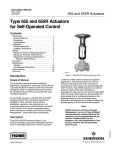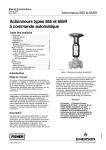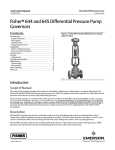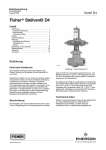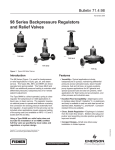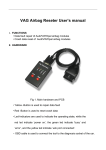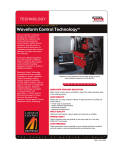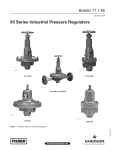Download Emerson Fisher 655R Instruction manual
Transcript
Instruction Manual 655 and 655R Actuators D100305X012 December 2010 Fisherr 655 and 655R Actuators for Self‐Operated Control Contents Figure 1. Fisher 655‐ED Pressure‐Reducing Valve Introduction . . . . . . . . . . . . . . . . . . . . . . . . . . . . . . . . . 1 Scope of Manual . . . . . . . . . . . . . . . . . . . . . . . . . . . . . 1 Description . . . . . . . . . . . . . . . . . . . . . . . . . . . . . . . . . 2 Specifications . . . . . . . . . . . . . . . . . . . . . . . . . . . . . . . 2 Installation . . . . . . . . . . . . . . . . . . . . . . . . . . . . . . . . . . . 2 Actuator Mounting . . . . . . . . . . . . . . . . . . . . . . . . . . . 3 Loading Connections . . . . . . . . . . . . . . . . . . . . . . . . . 7 Startup . . . . . . . . . . . . . . . . . . . . . . . . . . . . . . . . . . . . . . 7 Startup for Pressure‐Reducing Service . . . . . . . . . . . 7 Startup for Pressure‐Relief Service . . . . . . . . . . . . . . 7 Adjustment for Pressure‐Reducing or Pressure‐Relief Service . . . . . . . . . . . . . . . . . . . . . 8 Shutdown . . . . . . . . . . . . . . . . . . . . . . . . . . . . . . . . . . . 8 Maintenance . . . . . . . . . . . . . . . . . . . . . . . . . . . . . . . . . 8 Actuator . . . . . . . . . . . . . . . . . . . . . . . . . . . . . . . . . . . 9 Top‐Mounted Handwheel . . . . . . . . . . . . . . . . . . . . 12 Parts Ordering . . . . . . . . . . . . . . . . . . . . . . . . . . . . . . . 14 Parts List . . . . . . . . . . . . . . . . . . . . . . . . . . . . . . . . . . . 14 W0466‐1 Introduction Scope of Manual This instruction manual provides installation, adjustment, maintenance, and parts ordering for the Fisher 655 and 655R actuators and the top‐mounted handwheel. Refer to separate instruction manuals for information about valves and accessories used with these actuators. Do not install, operate, or maintain 655 or 655R actuators without being fully trained and qualified in valve, actuator, and accessory installation, operation and maintenance. To avoid personal injury or property damage, it is important to carefully read, understand, and follow all the contents of this manual, including all safety cautions and warnings. If you have any questions about these instructions, contact your Emerson Process Management sales office before proceeding. www.Fisher.com Instruction Manual 655 and 655R Actuators December 2010 D100305X012 Table 1. Specifications Actuator Sizes and Maximum Casing Pressures ACTUATOR SIZE MAXIMUM CASING PRESSURE Bar Psig 3A, 4A 17.2 250 3B, 4B 12.1 175 32, 42 6.9 100 33, 43 4.5 65 34, 44 3.1 45 35, 45 2.1 30 36, 46 1.0 15 Actuator Pressure Setting Ranges See table 2 Actuator Yoke Boss and Valve Stem Connection Diameters Sizes 3A through 36: 54 mm (2‐1/8 inch) yoke boss with 9.5 mm (3/8 inch) stem connection Sizes 4A through 46: 71 mm (2‐13/16 inch) yoke boss with 12.7 mm (1/2 inch) stem connection Maximum Travel Sizes 3A and 4A: 11 mm (0.4375 inch) plus 3 mm (0.125 inch) for seating All Other Sizes: 19 mm (0.75 inch) plus 3 mm (0.125 inch) for seating Effective Diaphragm Area See table 3 Spring Rate See key 6 in the parts list section Temperature Capabilities -29 to 82_C (-20 to 180_F) with standard diaphragm material. For the fluid and temperature capabilities of nonstandard diaphragm materials, consult your Emerson Process Management sales office Casing Pressure Connections 1/2 NPT internal Approximate Weights APPROXIMATE WEIGHT ACTUATOR SIZE Kg Lb 3A, 3B, 32, 33 20 45 34, 35, 36 23 50 4A, 4B, 42, 43 29 65 44, 45, 46 34 75 Description 655 and 655R actuators (figure 1) are pressure‐actuated, spring‐and‐diaphragm actuators used in conjunction with various valves to provide control for a wide variety of pressure regulation applications. 655 actuators are used for pressure‐reducing service when mounted on push‐down‐to‐close valves such as the Fisher ED and ET valves. 655R actuators are used for pressure‐relief service when mounted on push‐down‐to‐open valves such as the Fisher EDR and ETR valves. Both types are self‐operated and direct‐acting; that is, increasing pressure in the diaphragm casing forces the actuator stem downward, and decreasing the pressure allows the actuator spring to lift the actuator stem upward. Specifications Specifications for the 655 and 655R actuators are shown in table 1. Information for a specific actuator is also found on the nameplate of that actuator. Installation WARNING To avoid personal injury or property damage caused by bursting of pressure‐retaining parts, be certain the service conditions do not exceed the casing pressure limits listed in table 1. Use pressure‐limiting or pressure‐relieving devices to prevent service conditions from exceeding these limits. 2 Instruction Manual D100305X012 655 and 655R Actuators December 2010 Always wear protective gloves, clothing, and eyewear when performing any installation operations to avoid personal injury. Check with your process or safety engineer for any additional measures that must be taken to protect against process media. If installing into an existing application, also refer to the WARNING at the beginning of the Maintenance section in this instruction manual. 655 and 655R actuators are normally shipped mounted on a valve. Refer to the appropriate valve instruction manual when installing the valve in the pipeline. If the actuator is shipped separately or if it is necessary to mount the actuator on the valve, perform the procedures described in the Actuator Mounting portion of this section. CAUTION To avoid premature wear of the diaphragm due to debris in the pressure line to the diaphragm, install a strainer in the pipeline ahead of the regulator or relief valve. Before installing the actuator, inspect it for any damage. Also, keep any adjacent piping clean and free of pipe scale or other debris that could possibly disrupt service. It is recommended that a strainer be installed in the pipeline ahead of the regulator or relief valve to protect it while in service. And a conventional three‐valve bypass (see figure 2) should be placed around the regulator or relief valve to permit continuous operation when it is being installed or repaired. Actuator Mounting The actuator may be installed either above or below the pipeline. CAUTION In steam service applications, avoid premature wear of the diaphragm, due to high temperature steam, by installing the valve with the actuator positioned below the pipeline. If the regulator or relief valve is to be used for steam service, the valve should be installed with the actuator positioned below the pipeline, and the control line should be sloped down toward the diaphragm casing. This is to ensure that any forming condensate will maintain a water seal to protect the diaphragm. The following procedure describes how to mount the actuator on either a push‐down‐to‐close or a push‐down‐to‐open valve so that the actuator stem and valve stem thread engagement will allow full travel and proper shutoff. Refer to figure 3 for actuator mounting components. Key numbers refer to figure 4 unless otherwise stated. 1. Turn the adjusting screw (key 10) into the yoke (key 7) to force the diaphragm (key 2) and diaphragm plate (key 4) against the upper diaphragm casing (key 1). 2. Perform the following steps as appropriate for either push‐down‐to‐close or push‐down‐to‐open valve action. CAUTION In the following procedures, do not rotate the valve plug while it is seated since this may cause damage to the seating surfaces and thereby allow excessive leakage. Also, during travel adjustment, use tools carefully to avoid damaging the valve plug stem. A damaged stem could cut the packing and allow leakage. 3 655 and 655R Actuators Instruction Manual December 2010 D100305X012 For Push‐Down‐To‐Close Valves: a. Place the actuator part way over the valve stem. Then, place the yoke locknut over the valve stem, and slide the travel indicator disk (key 11, if used) on top of the hex nuts (key 12). b. Set the actuator onto the valve body. The length of the valve stem will prevent the actuator yoke (key 7) from sitting on the bonnet properly. Measure the distance from the bottom of the actuator yoke to the mating shoulder on the bonnet, and then add the valve plug travel to this measurement. c. Raise the actuator so the valve plug can be lifted off the seat ring. Note Either turn the actuator, or tighten the hex nuts together, and use a wrench on the hex nuts to turn the valve plug and stem assembly. Thread the valve stem into the actuator stem the distance measured in the previous step. d. Lower the actuator onto the valve body bonnet, and tighten the yoke locknut. e. Connect the pressure control lines as described in the Loading Connection portion of this section. f. Stroke the actuator, and measure the stem movement to check travel. If the movement is more than full travel, turn the valve stem out of the actuator stem the amount of over‐travel. If movement is less than full travel, turn the valve stem into the actuator stem the amount of under‐travel. For Push‐Down‐To‐Open Valves: a. Place the actuator, yoke locknut, and travel indicator disk (key 11, if used) over the valve stem. Support the actuator above the valve body so the actuator stem and valve stem do not contact when the valve plug is seated. b. Connect the pressure control lines as described in the Loading Connection portion of this section. c. Move the valve plug, by hand, from the seated to the open position, and make sure that valve stem movement corresponds to the desired travel. d. Stroke the actuator until the diaphragm plate (key 4) contacts the down travel stop (see figure 3). e. With the valve plug positioned as described in step c above, lower the actuator until the actuator stem contacts the valve stem, and measure the distance from the bottom of the actuator yoke to the mating shoulder on the bonnet. f. Thread the valve stem into the actuator stem until the thread engagement is equal to the distance measured in the previous step. Tighten the hex nuts (key 12) together, and use a wrench to turn the valve plug and stem assembly. g. Lower the actuator onto the valve body bonnet, and tighten the yoke locknut. h. Stroke the actuator, and measure the stem movement to check travel. If the movement is more than full travel, turn the valve stem into the actuator stem the amount of over‐travel. If the movement is less than full travel, turn the valve stem out of the actuator stem the amount of under‐travel. 4 Instruction Manual 655 and 655R Actuators D100305X012 December 2010 Table 2. Actuator Pressure‐Setting Ranges(1) ACTUA‐ TOR SIZE 3A, 4A 3B 4B 3B, 4B 32 42 32, 42 33 43 33, 43 34 SPRING PART NUMBER PRESSURE REDUCTION PRESSURE RELIEF Minimum Maximum Minimum Maximum Bar Psig Bar Psig Bar Psig Bar Psig 1E792427082 5.4 78 12.0 174 4.5 65 10.1 146 1F714327092 3.0 44 9.3 135 3.0 43 8.2 119 1F176927092 2.2 32 6.6 96 2.6 37 5.9 1F176827092 1.8 26 5.4 78 2.3 34 1F176727032 1.3 19 4.1 59 1.4 1E793327082 3.4 50 7.4 107 1E795427082 2.9 42 6.3 1E793327082 3.4 50 7.4 1E795427082 2.9 42 6.3 1E792427082 2.4 35 1F714327092 1.4 1F176927092 ACTUA‐ TOR SIZE SPRING PART NUMBER PRESSURE REDUCTION PRESSURE RELIEF Minimum Maximum Minimum Maximum Bar Psig Bar Psig Bar Psig Bar Psig 1E793327082 0.9 13 1.9 28 0.8 11 1.6 23 1E795427082 0.8 11 1.6 23 0.6 9.0 1.3 19 85 1E792427082 0.6 9.0 1.4 20 0.5 7.0 1.1 16 5.2 75 1F714327092 0.3 5.0 1.1 16 0.3 5.0 0.9 13 20 3.9 57 1F176927092 0.3 3.8 0.8 11 0.3 4.0 0.7 10 3.0 43 4.4 64 1F176827092 0.2 2.8 0.6 8.5 0.1 2.0 0.6 8.5 92 2.4 35 4.4 64 1E793327082 0.6 8.3 1.2 18 0.5 7.0 0.8 11 107 3.0 43 6.1 89 1E795427082 0.5 7.0 1.0 15 0.4 5.5 0.8 11 92 2.4 35 5.3 77 1E793327082 0.6 8.3 1.2 18 0.5 7.0 1.0 15 5.4 78 2.0 29 4.4 64 1E795427082 0.5 7.0 1.0 15 0.4 5.5 0.9 13 20 4.1 60 1.3 19 3.7 53 1E792427082 0.4 5.8 0.9 13 0.3 5.0 0.8 11 1.0 14 3.0 43 1.2 17 2.6 38 1F714327092 0.2 3.3 0.7 10 0.2 3.2 0.6 9.0 1E793327082 2.2 32 4.5 65 1.8 26 2.6 38 1F176927092 0.2 2.4 0.5 7.2 0.2 2.8 0.4 6.3 1E795427082 1.8 26 3.8 55 1.5 22 2.6 38 1F176827092 0.1 2.0 0.4 5.9 0.2 2.5 0.4 5.5 1E793327082 2.2 32 4.5 65 1.8 26 3.7 53 1F176727032 0.1 1.5 0.3 4.4 0.1 1.5 0.3 4.2 1E795427082 1.8 26 3.8 55 1.5 22 3.1 45 1F714427112 0.07 1.0 0.2 2.9 0.09 1.3 0.2 2.8 1E792427082 1.5 22 3.2 47 1.2 18 2.6 38 1E793327082 0.4 5.8 0.9 13 0.3 5.0 0.5 7.7 1F714327092 0.8 12 2.5 36 0.8 12 2.1 31 1E795427082 0.3 4.9 0.8 11 0.3 4.2 0.5 7.7 1E793327082 1.3 19 2.8 40 1.1 16 1.7 24 1E793327082 0.4 5.8 0.9 13 0.3 5.0 0.8 11 1E795427082 1.1 16 2.3 34 0.9 13 1.7 24 1E795427082 0.3 4.9 0.8 11 0.3 4.2 0.6 9.0 1E793327082 1.3 19 2.8 40 1.1 16 2.3 33 1E792427082 0.3 4.1 0.6 9.2 0.2 3.5 0.5 7.7 1E795427082 1.1 16 2.3 34 0.9 13 1.9 28 1F714327092 0.2 2.3 0.5 7.1 0.2 2.3 0.4 6.3 1E792427082 1.0 14 2.0 29 0.8 11 1.7 24 1F176927092 0.1 1.7 0.4 5.1 0.1 2.0 0.3 4.5 1F714327092 0.5 7.0 1.5 22 0.5 7.0 1.4 20 1F176827092 0.09 1.3 0.3 4.2 0.1 1.8 0.3 4.0 1F176927092 0.4 5.2 1.1 16 0.3 5.0 1.1 16 1F176727032 0.07 1.0 0.2 3.1 0.08 1.1 0.2 3.0 1E793327082 0.9 13 1.9 28 0.8 11 1.1 16 1F714427112 0.05 0.7 0.1 2.1 0.06 0.9 0.1 2.0 1E795427082 0.8 11 1.6 23 0.6 9.0 1.1 16 1F713027112 0.02 0.34 0.08 1.1 0.05 0.7 0.07 1.0 44 34, 44 35 45 35, 45 36 46 36, 46 1. Effects of packing box friction, unbalance, and weight of valve plug not considered in calculations. Figure 2. Typical Installation Schematics 1/2 NPT CONTROL LINE LARGE PORT NEEDLE VALVE LARGE PORT NEEDLE VALVE 1/2 NPT CONTROL LINE 655R ACTUATOR 655 ACTUATOR STRAINER 13A6502‐A 13A6503‐A A1628‐1 BYPASS LINE BYPASS LINE DIRECT‐ACTING BALANCED PLUG VALVE BODY PRESSURE‐REDUCING INSTALLATION STRAINER REVERSE‐ACTING BALANCED PLUG VALVE BODY PRESSURE‐RELIEF INSTALLATION 5 Instruction Manual 655 and 655R Actuators December 2010 D100305X012 Table 3. Effective Diaphragm Area(1) TRAVEL DOWN FROM UPPER CASING STOP, mm (IN.) ACTUA‐ TOR SIZE Cm2 In.2 Cm2 In.2 Cm2 In.2 Cm2 In.2 Cm2 In.2 Cm2 In.2 Cm2 In.2 Cm2 In.2 Cm2 In.2 Cm2 3A, 4A 66 10.2 62 9.6 61 9.5 61 9.4 59 9.2 59 9.1 57 8.9 56 8.7 ‐‐‐ ‐‐‐ ‐‐‐ ‐‐‐ 3B, 4B 152 23.5 139 21.6 136 21.1 134 20.8 132 20.5 131 20.3 130 20.1 128 19.8 117 18.1 103 16.0 32, 42 258 40.0 235 36.4 227 35.2 221 34.2 210 32.6 205 31.8 200 31.0 195 30.3 182 28.2 170 26.4 33, 43 406 63.0 374 58.0 366 56.8 358 55.5 345 53.5 340 52.7 335 52.0 330 51.2 318 49.3 307 47.6 34, 44 600 93.0 547 84.8 534 82.8 523 81.0 508 78.8 502 77.8 497 77.0 490 76.0 474 73.5 465 72.0 35, 45 865 134.0 834 129.2 821 127.2 809 125.4 788 122.2 777 120.5 768 119.0 759 117.6 736 114.1 723 112.0 36, 46 1230 190.0 1170 181.5 1150 179.0 1140 177.0 1120 173.5 1110 172.3 1100 171.0 1100 169.8 1070 166.5 1050 163.5 0 3 (0.125) 5 (0.1875) 6 (0.25) 10 (0.375) 11 (0.4375) 13 (0.5) 14 (0.5625) 19 (0.75) 22 (0.875) 1. For the spring rates of a particular spring, see key 6 in the Parts List section. Figure 3. Actuator/Valve Components DIAPHRAGM PLATE DOWN TRAVEL STOP ACTUATOR STEM ADJUSTING SCREW TRAVEL INDICATOR STEM HEX NUTS VALVE STEM YOKE LOCKNUT SEAT RING VALVE PLUG VALVE PLUG SEAT RING DV3742‐B DH4667‐B 31A0223‐B B0816‐1 6 PUSH‐DOWN‐TO‐CLOSE VALVE PUSH‐DOWN‐TO‐OPEN VALVE In.2 Instruction Manual 655 and 655R Actuators D100305X012 December 2010 3. After correct travel has been obtained, tighten the hex nuts (key 12) against the actuator stem (key 8), and tighten the yoke locknut with a hammer and punch. Note Changing the spring adjustment will not change the actuator pressure range for that particular spring (see table 2). Changing the spring adjustment merely shifts the position of the spring either up or down so that valve travel can coincide with the actuator pressure setting range. 4. While monitoring loading pressure with a pressure gauge, stroke the actuator, and then turn the adjusting screw until the valve begins to travel at the desired pressure. Turn the adjusting screw out of the yoke to decrease spring compression and thus allow the valve to begin travel at a lower loading pressure. Turn the adjusting screw into the yoke to increase spring compression and thus allow the valve to begin travel at a higher loading pressure. Loading Connections Install the control line following the steps listed below. Typical installations are shown in figure 2. 1. Connect the control line into either the upstream pipeline for pressure‐relief service or into the downstream pipeline for pressure‐reducing service as shown in figure 2. Make the pipeline tap at least four to eight pipe diameters away from the regulator or relief valve, or any elbow, swage, or nipple, to avoid abnormal velocities or turbulence. 2. Connect the other end of the control line to the 1/2 NPT connection in the center of the upper diaphragm casing (key 1) or to the connection in the handwheel body (key 28, figures 6 and 7; key 142, figure 5). 3. Fit the control line with a large‐port needle valve. Partially closing or throttling this valve will tend to dampen any cycling or pulsating action of the regulator. Never completely close the needle valve while the regulator is in operation. Startup The procedures for placing into operation and adjusting the equipment for both pressure‐reducing and pressure‐relief applications are described below. Typical installation schematics are shown in figure 2. Startup For Pressure‐Reducing Service 1. Open the needle valve in the control line. 2. Open the downstream shutoff valve. 3. Close the valve in the bypass line. 4. Slowly open the upstream shutoff valve. Startup For Pressure‐Relief Service 1. Open the needle valve in the control line. 2. Open the downstream shutoff valve. 3. Slowly open the upstream shutoff valve. 4. Close the valve in the bypass line. 7 655 and 655R Actuators Instruction Manual December 2010 D100305X012 Adjustment For Pressure‐Reducing or Pressure‐Relief Service The actuator is factory‐set as specified on the order, and the pressure range is stamped on the nameplate. If a pressure setting other than the one specified is desired, change the pressure setting by following the procedures listed below. Be sure to change the nameplate to indicate the new pressure setting. The new pressure setting must not exceed the limits given in tables 1 and 2 or in any applicable codes. CAUTION To protect equipment in the process system from a sudden release of pressure, always use a pressure gauge to monitor pressure when making adjustments. To adjust the downstream pressure setting for pressure‐reducing service, or the upstream pressure setting for pressure‐relief service, proceed as follows. To decrease the pressure setting, turn the adjusting screw (key 10, figure 4) counterclockwise; to increase the pressure setting, turn the adjusting screw clockwise. If the spring does not provide the required pressure setting, replace it through the following steps: 1. Disassemble the actuator by following steps 1, 3 and 4 of the Disassembly portion of the Maintenance section. 2. Remove the diaphragm (key 2). Then, unscrew the cap screw (key 3), and lift the diaphragm plate (key 4) out of the actuator body. 3. Replace the spring and reassemble the actuator by following steps 5 and 6 of the Assembly portion of the Maintenance section. Shutdown For both pressure‐reducing and pressure‐relief applications, refer to figure 2, and follow the procedures described below. 1. Close the upstream shutoff valve slightly. 2. Slowly open the bypass valve while monitoring downstream pressure. 3. Slowly close the downstream shutoff valve. 4. Close the upstream shutoff valve. 5. Close the needle valve in the control line. Maintenance Actuator parts are subject to normal wear and must be inspected and replaced when necessary. The frequency of inspection and replacement depends on the severity of service conditions. WARNING Avoid personal injury or property damage from sudden release of process pressure or bursting of parts. Before performing any maintenance operations: 8 Instruction Manual 655 and 655R Actuators D100305X012 December 2010 D Do not remove the actuator from the valve while the valve is still pressurized. D Always wear protective gloves, clothing, and eyewear when performing any maintenance operations to avoid personal injury. D Disconnect any operating lines providing air pressure, electric power, or a control signal to the actuator. Be sure the actuator cannot suddenly open or close the valve. D Use bypass valves or completely shut off the process to isolate the valve from process pressure. Relieve process pressure from both sides of the valve. Drain the process media from both sides of the valve. D Vent the power actuator loading pressure and relieve any actuator spring precompression. D Use lock‐out procedures to be sure that the above measures stay in effect while you work on the equipment. D The valve packing box may contain process fluids that are pressurized, even when the valve has been removed from the pipeline. Process fluids may spray out under pressure when removing the packing hardware or packing rings, or when loosening the packing box pipe plug. D Check with your process or safety engineer for any additional measures that must be taken to protect against process media. The maintenance instructions are divided into two sections: Actuator and Top‐Mounted Handwheel. Actuator This procedure describes how the actuator can be completely disassembled and assembled. When inspection or repairs are required, disassemble only those parts necessary to accomplish the job; then, start the assembly at the appropriate step. Key numbers refer to figure 4. Disassembly CAUTION In the following procedure, do not rotate the valve plug while it is seated since this may cause damage to the seating surfaces and thereby allow excessive leakage. Also, during travel adjustment, use tools carefully to avoid damaging the valve plug stem. A damaged stem could cut the packing and allow leakage. 1. Rotate the handwheel (if one is used) counterclockwise to be sure the handwheel is not compressing the spring (key 6). 2. For complete disassembly, the actuator must be removed from the valve, and the actuator stem (key 8) must be completely disengaged from the valve plug stem by rotating the actuator. Perform the appropriate procedure according to the respective valve action. For Push‐Down‐To‐Close Valves: Note To prevent the actuator stem (key 8) from rotating while performing the following procedure, make sure the adjusting screw (key 10) remains screwed into the yoke (key 7). 9 655 and 655R Actuators Instruction Manual December 2010 D100305X012 a. Loosen the two hex nuts (key 12). b. Loosen the yoke locknut (figure 3) with a hammer and punch, and unscrew it from the valve bonnet. c. While lifting the actuator so that the valve plug is not forced against the seat, rotate the entire actuator until the actuator stem disengages completely from the valve plug stem. For Push‐Down‐To‐Open Valves: a. Turn the adjusting screw (key 10) counterclockwise to relieve all spring compression. Then, move the valve plug, by hand, off the seat. b. Loosen the hex nuts (key 12), and unscrew the valve plug stem out of the actuator stem as far as it will go. c. Turn the adjusting screw into the yoke (key 7) to force the diaphragm (key 2) and diaphragm plate (key 4) against the upper diaphragm casing (key 1). d. Loosen the yoke locknut (figure 3) with a hammer and punch, and unscrew it from the valve bonnet. e. Rotate the entire actuator until the actuator stem disengages from the valve plug stem. 3. Turn the adjusting screw (key 10) counterclockwise out of the yoke (key 7) to relieve all spring compression. 4. To remove the upper diaphragm casing (key 1), unscrew the cap screws (key 19) for size 3A and 4A actuators or the cap screws and hex nuts (keys 19 and 20) for all other sizes. 5. Remove the diaphragm (key 2); then, lift the diaphragm plate (key 4) and actuator stem assembly out of the actuator body. Also, remove the spring and the lower spring seat (key 9). 6. For size 3A and 4A actuators, remove the lower diaphragm casing (key 5). 7. Remove the cap screw (key 3), and separate the diaphragm plate from the actuator stem. 8. For size 3B through 46 actuators, unscrew the cap screws (key 21), and remove the lower diaphragm casing (key 5). Some 655R actuators will have travel stops (key 13, not shown) in place of three of these six cap screws. 9. If a top‐mounted handwheel assembly is used, refer to steps 4 through 8 of the Disassembly portion of the Top‐Mounted Handwheel section. Assembly This procedure assumes that the actuator is completely disassembled. If it is not, start the instructions at the appropriate step. 1. Before starting assembly, apply moly‐grease lubricant to the threads and the bearing end of the adjusting screw (key 10) as indicated in figure 4 by the letter A. 2. For size 3A and 4A actuators, set the lower diaphragm casing (key 5) onto the yoke (key 7). 3. For size 3B through 46 actuators, install the lower diaphragm casing (key 5), and secure it with the cap screws (key 21). Some 655R actuators will have travel stops (key 13, not shown) in place of three of these six cap screws. 4. Install the lower spring seat (key 9) and the actuator spring (key 6). Note To take some of the slack out of the diaphragm (key 2) at the bolt circle, turn the adjusting screw into the yoke (key 7) to raise the diaphragm plate (key 4). This will also ensure that the diaphragm will have enough slack inside the casings for efficient travel. 10 Instruction Manual D100305X012 655 and 655R Actuators December 2010 5. Secure the diaphragm plate (key 4) to the actuator stem (key 8) with the cap screw (key 3), and install this assembly into the actuator. Install the diaphragm, making sure that the patterned side of the diaphragm is next to the diaphragm plate. Note When replacing the upper diaphragm casing (key 1), be sure there are no wrinkles in the diaphragm that might cause the diaphragm to tear or allow leakage. 6. Place the upper diaphragm casing onto the lower diaphragm casing. For size 3A and 4A actuators, secure the casings with the cap screws (key 19). For all other actuator sizes, secure the casing with the cap screws and hex nuts (keys 19 and 20). Note When you replace actuator diaphragms in the field, take care to ensure the diaphragm casing bolts are tightened to the proper load to prevent leakage, but not crush the material. Perform the following tightening sequence with a manual torque wrench. CAUTION Over‐tightening the diaphragm cap screws (key 19) or cap screws and nuts (keys 19 and 20) can damage the diaphragm. Do not exceed 27 NSm (20 lbfSft) torque. Note Do not use lubricant on these bolts and nuts. Fasteners must be clean and dry. 7. Install the upper diaphragm casing (key 1), and install the cap screws (key 19) or cap screws and nuts (keys 19 and 20). Tighten in the following manner. 8. The first four bolts tightened should be diametrically opposed and 90 degrees apart. Tighten these four bolts to 13 NSm (10 lbfSft). 9. Tighten the remaining bolts in a clockwise, criss‐cross pattern to 13 NSm (10 lbfSft). 10. Repeat this procedure by tightening four bolts, diametrically opposed and 90 degrees apart, to a torque of 27 NSm (20 lbfSft). 11. Tighten the remaining bolts in a clockwise, criss‐cross pattern to 27 NSm (20 lbfSft). 12. After the last bolt is tightened to 27 NSm (20 lbfSft), all of the bolts should be tightened again to 27 NSm (20 lbfSft) in a circular pattern around the bolt circle. 13. Once completed, no more tightening is recommended. 14. Mount the actuator onto the valve by following the procedures outlined in the Actuator Mounting portion of the installation section. 15. Connect the pressure control line by following the procedures outlined in the Loading Connections portion of the Installation section. 11 655 and 655R Actuators December 2010 Instruction Manual D100305X012 16. To start up and adjust the actuator, follow the procedures outlined in the Startup section of this instruction manual. Top‐Mounted Handwheel Top‐mounted handwheel assemblies (figures 6, 7 and 5) are normally used as adjustable travel stops to limit full upward travel of the actuator stem. Turning the handwheel clockwise forces the actuator stem downward, while turning the handwheel counterclockwise allows the spring to force the actuator stem upward. If the actuator is used with a push‐down‐to‐close valve, full opening of the valve plug can be restricted through the appropriate positioning of the top‐mounted handwheel. If the actuator is used with a push‐down‐to‐open valve, closing of the valve plug can be restricted by using the handwheel. A locknut (key 27, figures 6 and 7; key 137, figure 5) is used to hold the handwheel in position. Instructions are given below for complete disassembly and assembly. Perform the disassembly only as necessary to accomplish the required maintenance; then, begin the assembly at the appropriate step. Key numbers refer to figure 6 for size 3A and 4A, figure 7 for size 3B and 4B, and figure 5 for size 32 through 46 top‐mounted handwheel assemblies. Disassembly 1. Bypass the control valve. Relieve all loading pressure, and remove the tubing or pipe from the handwheel body. 2. Loosen the hex nut (key 27, figures 6 and 7; key 137, figure 5). Turn the adjusting screw (key 10, figure 4) and the handwheel (key 25, figures 6 and 7; key 51, figure 5) counterclockwise to relieve all compression. 3. For size 3A and 4A actuators, remove the cap screws (key 19, figure 4), and lift the handwheel body (key 28, figure 6) off the actuator. 4. For size 3B through 46 actuators, remove the cap screws and hex nuts (keys 19 and 20, figure 4), and then lift off the upper diaphragm casing (key 1, figure 4) and handwheel assembly. To replace the O‐ring (key 139, figure 5) or for ease of handling, separate the handwheel assembly from the upper diaphragm casing. This can be accomplished by removing the cap screws that secure the handwheel assembly to the upper diaphragm casing (key 33, figure 7; key 141, figure 5). 5. Turn the handwheel clockwise two or three turns. Remove the hex nut (key 22, figures 6 and 7; key 54, figure 5) and washer (key 24, figures 6 and 7; key 134, figure 5), and lift off the handwheel. 6. Unscrew the locknut (key 27, figures 6 and 7; key 137, figure 5) from the handwheel stem (key 26, figures 6 and 7; key 133, figure 5), and then remove the handwheel stem through the bottom of the handwheel body (key 28, figures 6 and 7; key 142, figure 5). A screwdriver slot in the top of the handwheel stem is provided for this purpose. 7. Check the O‐ring (key 29, figures 6 and 7; key 138, figure 5), and replace it if necessary. 8. To complete disassembly, drive out the groove pin (key 31, not shown; key 140, figure 5), and slide the pusher plate (key 32, figures 6 and 7; key 135, figure 5) off the handwheel stem. For 655, size 3B and 4B actuators, a travel stop (key 34, figure 7) should also be removed with these parts. Assembly This procedure assumes that the handwheel assembly is completely disassembled. If it is not, start the instructions at the appropriate step. 1. During assembly, apply lithium grease lubricant (key 241) to the handwheel stem and threads, the pusher, and to the O‐rings as shown in figures 6, 7 and 5. 2. Slide the pusher plate (key 32, figures 6 and 7; key 135, figure 5) onto the handwheel stem, and, if necessary, insert the groove pin (key 31, not shown; key 140, figure 5). For 655, size 3B and 4B actuators, a travel stop (key 34, figure 7) should also be inserted on the handwheel stem with these parts. 12 Instruction Manual D100305X012 655 and 655R Actuators December 2010 3. Insert the handwheel stem into the handwheel body (key 28, figures 6 and 7; key 142, figure 5); then, screw the hex nut (key 27, figures 6 and 7; key 137, figure 5) onto the handwheel stem. 4. Install the handwheel (key 25, figures 6 and 7; key 51, figure 5) and washer (key 24, figures 6 and 7; key 134, figure 5) onto the handwheel stem, and secure it with the hex nut (key 22, figures 6 and 7; key 54, figure 5). 5. For size 3A and 4A actuators, set the handwheel body onto the actuator, and secure it with the cap screws (key 19, figure 4). Note When you replace actuator diaphragms in the field, take care to ensure the diaphragm casing bolts are tightened to the proper load to prevent leakage, but not crush the material. Perform the following tightening sequence with a manual torque wrench. CAUTION Over‐tightening the diaphragm cap screws (key 19) can damage the diaphragm. Do not exceed 27 NSm (20 lbfSft) torque. Note Do not use lubricant on these bolts and nuts. Fasteners must be clean and dry. 6. Install the upper diaphragm casing (key 1), and install the cap screws (key 19). Tighten in the following manner. 7. The first four bolts tightened should be diametrically opposed and 90 degrees apart. Tighten these four bolts to 13 NSm (10 lbfSft). 8. Tighten the remaining bolts in a clockwise, criss‐cross pattern to 13 NSm (10 lbfSft). 9. Repeat this procedure by tightening four bolts, diametrically opposed and 90 degrees apart, to a torque of 27 NSm (20 lbfSft). 10. Tighten the remaining bolts in a clockwise, criss‐cross pattern to 27 NSm (20 lbfSft). 11. After the last bolt is tightened to 27 NSm (20 lbfSft), all of the bolts should be tightened again to 27 NSm (20 lbfSft) in a circular pattern around the bolt circle. 12. Once completed, no more tightening is recommended. Proceed to step 21. 13. For size 3B through 46 actuators, set the upper diaphragm casing (key 1, figure 4) and handwheel assembly onto the actuator body, and secure it with the cap screws and hex nuts (keys 19 and 20, figure 4). Note When you replace actuator diaphragms in the field, take care to ensure the diaphragm casing bolts are tightened to the proper load to prevent leakage, but not crush the material. Perform the following tightening sequence with a manual torque wrench. CAUTION Over‐tightening the diaphragm cap screws and nuts (keys 19 and 20) can damage the diaphragm. Do not exceed 27 NSm (20 lbfSft) torque. 13 Instruction Manual 655 and 655R Actuators December 2010 D100305X012 Note Do not use lubricant on these bolts and nuts. Fasteners must be clean and dry. 14. Install the upper diaphragm casing (key 1), and install the cap screws and nuts (keys 19 and 20). Tighten in the following manner. 15. The first four bolts tightened should be diametrically opposed and 90 degrees apart. Tighten these four bolts to 13 NSm (10 lbfSft). 16. Tighten the remaining bolts in a clockwise, criss‐cross pattern to 13 NSm (10 lbfSft). 17. Repeat this procedure by tightening four bolts, diametrically opposed and 90 degrees apart, to a torque of 27 NSm (20 lbfSft). 18. Tighten the remaining bolts in a clockwise, criss‐cross pattern to 27 NSm (20 lbfSft). 19. After the last bolt is tightened to 27 NSm (20 lbfSft), all of the bolts should be tightened again to 27 NSm (20 lbfSft) in a circular pattern around the bolt circle. 20. Once completed, no more tightening is recommended. 21. Connect the pressure control line to the top‐mounted handwheel assembly by following the procedures outlined in the Loading Connections portion of the Installation section. 22. To start up and adjust the actuator, follow the procedures outlined in the Startup section of this instruction manual. Parts Ordering When corresponding with your Emerson Process Management sales office about this equipment, refer to the serial number found on the actuator nameplate (key 17, figure 4). Also, specify the complete 11‐character part number from the following parts list when ordering replacement parts. WARNING Use only genuine Fisher replacement parts. Components that are not supplied by Emerson Process Management should not, under any circumstances, be used in any Fisher valve, because they may void your warranty, might adversely affect the performance of the valve, and could cause personal injury and property damage. Note Neither Emerson, Emerson Process Management, nor any of their affiliated entities assumes responsibility for the selection, use and maintenance of any product. Responsibility for the selection, use, and maintenance of any product remains with the purchaser and end user. Parts List Actuator Key Note Part numbers are shown for recommended spares only. For part numbers not shown, contact your Emerson Process Management sales office. 14 Description 1 Upper Diaphragm Casing 2* Diaphragm, chloroprene Sizes 3A & 4A Sizes 3B & 4B Sizes 32 & 42 W/o top‐mounted handwheel W/ top‐mounted handwheel *Recommended spare parts Part Number 1F725102192 1F725902192 1F702202112 1F702202192 Instruction Manual 655 and 655R Actuators D100305X012 Key Description Sizes 33 & 43 W/o top‐mounted handwheel W/ top‐mounted handwheel Sizes 34 & 44 W/o top‐mounted handwheel W/ top‐mounted handwheel Sizes 35 & 45 W/o top‐mounted handwheel W/ top‐mounted handwheel Sizes 36 & 46 W/top‐mounted handwheel 3 Cap Screw 4 Diaphragm Plate 5 Lower Diaphragm Casing 6 Spring See following table 7 Yoke 8 Actuator Stem 9 Lower Spring Seat 10 Adjusting Screw 11 Travel Indicator Disk 12 Hex Nut 13 Travel Stop 14 Screw 15 Travel Indicator Scale 16 Twin Speed Nut 17 Nameplate 18 Drive Screw 19 Cap Screw 20 Hex Nut 21 Cap Screw December 2010 Part Number Figure 4. Fisher 655 Actuator 1F702302112 1F7023X0012 1F702402112 1F7024X0022 1F702502112 1F7025X0022 1F7026X0012 30A8341‐A Top‐Mounted Handwheel A APPLY MOLY‐GREASE LUBRICANT TO ADJUSTING SCREW Sizes 3A, 4A, 3B & 4B 22 24 25 26 27 28 29* 30* 31 32 33 34 Hex Jam Nut Washer Handwheel Handwheel Stem Hex Jam Nut Handwheel Body O‐Ring, nitrile O‐Ring, nitrile (not shown) Sizes 3B & 4B only Groove Pin Pusher Plate Cap Screw Travel Stop 1D237506992 1D267306992 Sizes 32 thru 46 51 54 133 134 135 137 138* 139* 140 141 142 241 Handwheel Hex Nut Handwheel Stem Washer Pusher Hex Nut O‐Ring, nitrile O‐Ring, nitrile Groove Pin Cap Screw Handwheel Body Lithium grease lubricant‐1, 0.396 kg (14 oz.) can (not furnished with actuator) *Recommended spare parts 30A8342‐A SIZE 3A AND 4A ACTUATOR DIAPHRAGM CASINGS 1D237506992 1D267306992 15 Instruction Manual 655 and 655R Actuators December 2010 Figure 5. Size 32 through 46 Top‐Mounted Hand wheel Assembly D100305X012 Figure 7. Size 3B and 4B Top‐Mounted Handwheel Assembly BV8008‐E Figure 6. Size 3A and 4A Top‐Mounted Handwheel Assembly APPLY LUB PARTS NOT SHOWN : 30 & 31 38A1217‐B Key 6 Spring, steel COLOR CODE APPLY LUB PART NOT SHOWN : 31 28A1216‐C SPRING RATE SAFE LOAD N/mm Lb/in. N Lb Aluminum red 22 123 1290 290 Aluminum & dark green 43 246 2420 545 Dark green 64 368 3750 843 Aluminum 86 490 4720 1060 Dark blue 107 612 5200 1187 Aluminum & dark blue 145 830 7250 1630 Light blue 220 1260 8184 1840 Light green 257 1470 9790 2200 Light grey 310 1770 11,600 2600 Yellow 368 2100 13,500 3045 Dark grey 129 735 5160 1160 Aluminum & brown 175 1000 7000 1575 White 441 2520 14,010 3150 Fisher is a mark owned by one of the companies in the Emerson Process Management business division of Emerson Electric Co. Emerson Process Management, Emerson, and the Emerson logo are trademarks and service marks of Emerson Electric Co. All other marks are the property of their respective owners. The contents of this publication are presented for informational purposes only, and while every effort has been made to ensure their accuracy, they are not to be construed as warranties or guarantees, express or implied, regarding the products or services described herein or their use or applicability. All sales are governed by our terms and conditions, which are available upon request. We reserve the right to modify or improve the designs or specifications of such products at any time without notice. Neither Emerson, Emerson Process Management, nor any of their affiliated entities assumes responsibility for the selection, use or maintenance of any product. Responsibility for proper selection, use, and maintenance of any product remains solely with the purchaser and end user. Emerson Process Management Marshalltown, Iowa 50158 USA Sorocaba, 18087 Brazil Chatham, Kent ME4 4QZ UK Dubai, United Arab Emirates Singapore 128461 Singapore www.Fisher.com 16 EFisher Controls International LLC 1975, 2010; All Rights Reserved
















